Excerpts from Jim Conrad's
Naturalist Newsletter
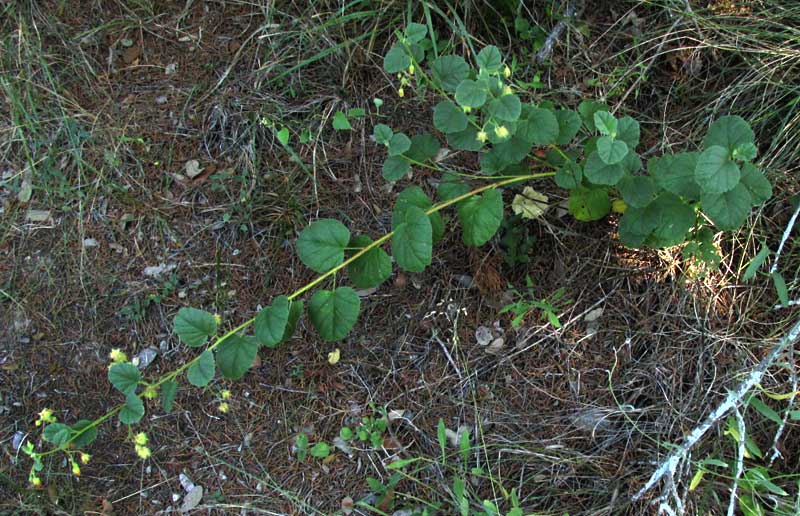
from the August 10, 2014 Newsletter issued from the Frio Canyon Nature Education Center in the valley of the Dry Frio River in northern Uvalde County, southwestern Texas, on the southern border of the Edwards Plateau; elevation ~1750m (~5750 ft); N29.62°, W99.86°; USA
TEXAS BURSTWORT
I've just about given up hope of finding new wildflowers alongside the single little road I bike up and down the Dry Frio River Valley, week after week. Therefore you can imagine my delight when this week something completely new turned up, and it wasn't even one of the many look-alike species of yellow-flowered daisies so easy to overlook, but rather something unlike anything I'd ever seen. Above, you can see the knee-high plant leaning toward the road's sunlight from below an Ashe Juniper. A close-up of some flowers and immature fruits is shown below:

At this point I was already pretty sure that we had a member of the Hibiscus Family, for the herbage and growth form look like any number of members of that family, plus such five-cornered fruits are common in the family, though I don't recall any as spiny-margined as these apparently are. An even closer look, showing most parts densely covered with hairs appears below:
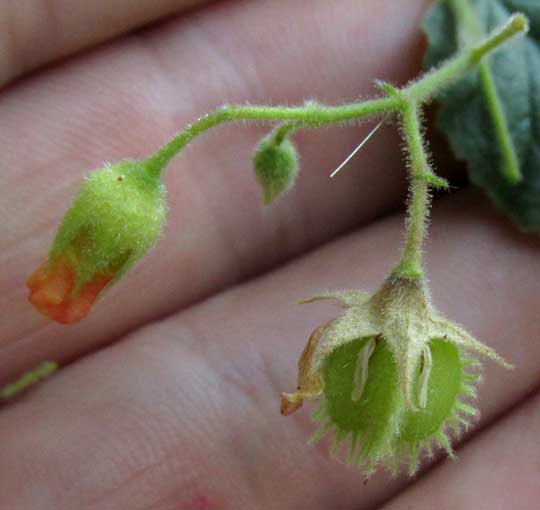
This close view was confusing, especially the immature fruit at the right. Those pale, banana-shaped items occupying the sinuses between the fruit's five "wings" are the stamens' pollen-producing anthers. The most important field mark of the Hibiscus Family is that stamens in that family normally are numerous, with filaments uniting at their bases into cylindrical "staminal columns" surrounding part of the female pistil. But this flower appears to possess only five stamens and there's no conspicuous staminal columns. You might like to compare our plant's stamen arrangement with a more typical staminal column surrounding the style of a hibiscus flower in Mexico, the column bristling with the stamens' cream-colored filaments and yellow anthers, at http://www.backyardnature.net/n/11/110109hj.jpg.
The Hibiscus Family is huge and is home to some real oddities, but could it accommodate such departures from the norm as this? I looked even closer at the fruit, shown below:
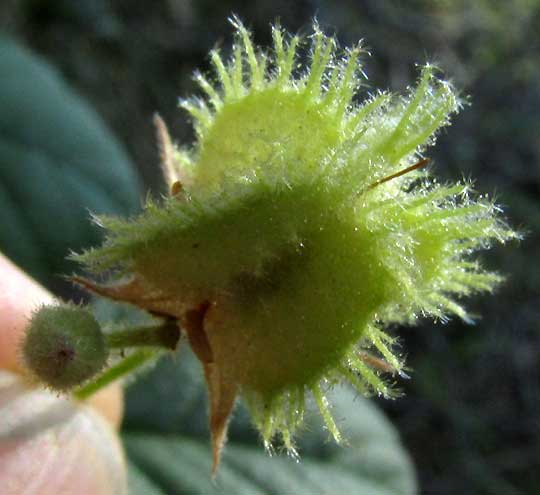
Here we see that the hairs covering the five-winged fruit are many-pointed compound ones, looking like spiny sea-urchins -- they're "stellate" hairs. However, stellate hairs are to be expected in the Hibiscus Family and some closely related families.
Another point of confusion was that I had interpreted the small, drooping flowers as immature, later to open into blossoms more typical of the Hibiscus Family. However, a closer look showed that mature flowers remained tiny and tube-like with narrow openings pointed downward, ready for pollinators, as seen below:
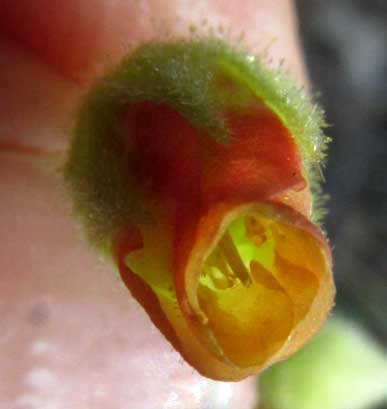
A side view of the same flower from the side is shown below:
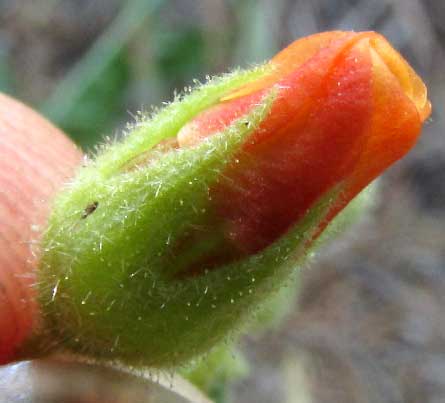
Breaking open a flower brought even more confusion. You can see why below:

Outermost there's the green, hairy calyx where it's supposed to be. Just inside that there's the colored corolla, also properly situated. But then at the flower's bottom, in the center, there's a stem atop which it appears to be the egg-shaped ovary, but that ovary seems to be enveloped with the greenish petals of a second corolla. This is unheard of. It didn't start making sense until a more mature fruit was bent over, revealing a little stem below it, shown below:
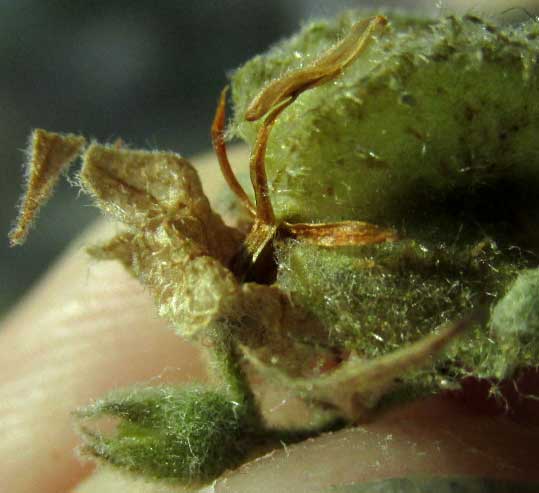
Now I understood. The innermost "green corolla" was actually flattened filaments of the five stamens, with their anthers fallen off. In the above picture the brown anthers are still attached. Moreover, now it looks as if the filaments really do unite into a staminal column surrounding the base of the ovary/fruit. Now it's seeming like the Hibiscus Family again.
To shorten the story, which took some time to work out, our plant is HERMANNIA TEXANA, in the whole world found only in southwestern Texas and adjacent northeastern Mexico. In books it's variously known as Texas Burstwort, Mexican Mallow and Texas Hermannia, but these seem to be made up by editors. I don't believe it has a good English name, but I'll use Texas Burstwort just for the pleasure of using the word "burstwort."
Our Texas Burstwort is not included on Texas A&M University's Checklist of Texas plants because Texas A&M's experts consider it a member of the Cacao or Chocolate Family, the Sterculiaceae. However, recent genetic studies indicate that the Cacao Family is inseparable from the Hibiscus Family, so now most experts place Hermannia among the hibiscuses. The confusion just highlights Hermannia's peculiarities.
The genus Hermannia is mainly South African, but a few species, like ours, live scattered around the globe. Just about everything known about the genus is found at http://www.malvaceae.info/Genera/Hermannia/Hermannia.html.
Texas Burstwort is described as growing in dry, rocky, calcareous or gypseous soils of the Edwards Plateau and the South Texas Plains, and that's what we have.